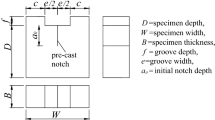Abstract
The complexity of the full BP-KX model for creep and shrinkage prediction presented in the previous five parts is due to the large number of influencing factors taken into consideration rather than an inherent complexity of the theory. However, a sophisticated model with all these factors is needed only for the design of special structures, such as bridges of a record span, buildings of a record height, or nuclear reactor structures. For most practical applications, many of the factors can be eliminated and can be fixed at their typical values. This yields a simplified BP-KX model which is presented in this last part. The simplified model should suffice for many practical applications and is suitable for standard code-type recommendations of engineering societies. The design of every structure can begin with this simplified model, and only if the effects of creep and shrinkage are found rather significant is analysis according to the full BP-KX model necessary.
Resume
On doit attribuer la complexité du modèle intégral BP-KX pour la prédiction du fluage et retrait du béton présenté dans les cinq chapîtres précédents au grand nombre de facteur déterminants pris en considération plutôt qu'à une complexité inhérente à la théorie. Cependant, un modèle sophistiqué comportant tous ces facteurs est nécessaire seulement pour le calcul des structures telles que des ponts de très grande portée, des bâtiments de très grande hauteur ou des réacteurs nucléaires. Dans la plupart des applications pratiques, de nombreux facteurs peuvent être éliminés et fixés à leurs valeurs typiques, ce qui donne un modèle BP-KX simplifié que nous présentons dans cette dernière partie. Le modèle devrait suffire pour de nombreuses applications pratiques et convient pour les recommendations à usage de code ou de norme dans l'industrie. On peut commencer le calcul de n'importe quelle structure à l'aide de ce modèle simplifié et, seulement si l'effet du fluage ou du retrait paraît assez marqué, recourir à l'analyse selon le modèle intégral BP-KP.
Similar content being viewed by others
References
Bažant, Z. P., Kim, J.-K. and Panula, L., ‘Improved prediction model for time-dependent deformations of concrete: Part 1—Shrinkage’,Mater. Struct. 24(143) (1991) 327–345.
Bažant, Z. P. and Kim, J.-K., ‘Improved prediction model for time-dependent deformations of concrete: Part 2—Basic creep’,ibid. 24(144) (1991) 409–421.
Idem, ‘Improved prediction model for time-dependent deformations of concrete: Part 3—Creep at drying’,ibid,25(145) (1992) 21–28.
Idem, ‘Improved prediction model for time-dependent deformations of concrete: Part 4—Temperature effects’,ibid.25(146) (1992) 84–94.
Idem, ‘Improved prediction model for time-dependent deformations of concrete: Part 5—Cyclic load and cyclic humidity’,ibid.25(147) (1992) 163–169.
Kesler, C. E., Wallo, E. M. and Yuan, R. L., ‘Free shrinkage of concrete and mortar’, T&AM Report No. 664 (Department of Theoretical and Applied Mechanics, University of Illinois, Urbana, 1966).
Wittmann, F. H., Bažant, Z. P., Alou, F. and Kim, J. K., ‘Statistics of shrinkage test data’,Cement Concr Aggreg. 9(2) (1987) 129–153, and privately communicated latest unpublished measurements (1991).
York, G. P., Kennedy, T. W. and Perry, E. S., ‘Experimental investigation of creep in concrete subjected to multiaxial compressive stresses and elevated temperatures’, Research Report 2864-2 to Oak Ridge National Laboratory (Department of Civil Engineering, University of Texas, Austin, June 1970); see also ‘Concrete for Nuclear Reactors’, American Concrete Institute Special Publication No. 34 (1972) pp. 647–700.
Kommendant, G. J., Polivka, M. and Pirtz, D., ‘Study of concrete properties for prestressed concrete reactor vessels, final report—part II, Creep and strength characteristics of concrete at elevated teeperatures’, Report No. UCSESM 76-3 to General Atomic Company (Department of Civil Engineering, University of California, Berkeley, 1976).
Rostasy, F. S., Teichen, K.-Th. and Engelke H., ‘Beitrag zur Klärung des Zusammenhanges von Kriechen und Relaxation bei Normal-beton’, Amtliche Forschungs-und Materialprüfungsanstalt für das Bauwesen, Heft 139 (Otto-Graf-Institute, Universität Stuttgart, Strassenbau und Strassenverkehrstechnik, 1972).
Troxell, G. E., Raphael, J. E. and Davis, R. W., ‘Long-time creep and shrinkage tests of plain and reinforced concrete’,Proc. ASTM 58 (1958) 1101–1120.
Bažant, Z. P. and Panula, L. ‘Creep and shrinkage characterization for prestressed concrete structures’,Journal of the Prestressed Concrete Institute 25 (1980) 86–122.
Author information
Authors and Affiliations
Additional information
Deceased 1989.
Rights and permissions
About this article
Cite this article
Bažant, Z.P., Panula, L., Kim, JK. et al. Improved prediction model for time-dependent deformations of concrete: Part 6—Simplified code-type formulation. Materials and Structures 25, 219–223 (1992). https://doi.org/10.1007/BF02473066
Issue Date:
DOI: https://doi.org/10.1007/BF02473066




